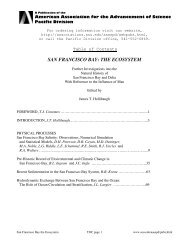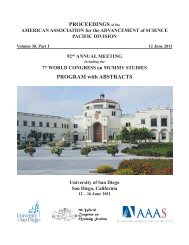Vol 31, Part I - forums.sou.edu ⢠Index page - Southern Oregon ...
Vol 31, Part I - forums.sou.edu ⢠Index page - Southern Oregon ...
Vol 31, Part I - forums.sou.edu ⢠Index page - Southern Oregon ...
Create successful ePaper yourself
Turn your PDF publications into a flip-book with our unique Google optimized e-Paper software.
ABSTRACTS – Symposia/Contributed Oral Papers<br />
energy barriers throughout the reaction process, and have<br />
a great effect on the function of the ligand after the reaction<br />
process. Since the precise mechanism of interaction<br />
between an enzyme and its ligand(s) is highly disputed, providing<br />
additional insight into this phenomenon is of great<br />
importance. Forced unbinding studies using atomic force<br />
microscopy (AFM) have contributed valuable information<br />
about the interactions between biomolecules. The strength<br />
of intermolecular interactions can be observed by attaching<br />
the enzyme and ligand molecules to the AFM tip and<br />
sample surfaces through tethering molecules, and measuring<br />
the unbinding force required to pull the molecules apart. By<br />
applying a previously modified, freely jointed chain model,<br />
along with additional mathematical analyses, we were able<br />
to determine the unbinding mechanism in a model enzyme/<br />
inhibitor system consisting of 5’-Methylthioadenosine/Sadenosylhomocysteine<br />
nucleosidase and its transition state<br />
analog, Homocysteinyl Immucillin A. Our data suggest that<br />
in this system the unbinding mechanism follows a process<br />
of elastic deformation. This type of observational method<br />
has the potential to greatly improve our understanding of<br />
enzymatic interactions as well as the production of powerful<br />
inhibitory drugs.<br />
103 Ab initio QM/MM Molecular Dynamics with AMBER and<br />
TeraChem: Exploring Environmental Effects on the Absorption<br />
Spectrum of Photoactive Yellow Protein, ANDREAS W<br />
GOETZ (San Diego Supercomputer Center 10100 Hopkins<br />
Drive, La Jolla, CA 92093; agoetz@sdsc.<strong>edu</strong>).<br />
We have recently extended the mixed quantum mechanical<br />
/ molecular mechanical (QM/MM) capabilities of the<br />
AMBER molecular dynamics (MD) software package to<br />
include ab initio and density functional theory (DFT) methods<br />
via an interface to external QM software packages. Of<br />
particular interest is our support of the electronic structure<br />
code TeraChem that exploits the massive parallelism of GPU<br />
accelerators to speed up ground and excited state calculations.<br />
We describe the interface between AMBER and TeraChem<br />
and present results for absorption spectra of photoactive<br />
yellow protein (PYP) obtained from time-dependent<br />
DFT calculations within the QM/MM framework along<br />
MD trajectories. The effects of long-range electrostatics are<br />
explored by computing the spectra for various QM regions<br />
and MM cutoff values. Comparisons are made to spectra calculated<br />
for the PYP chromophore in vacuum and aqueous<br />
solution.<br />
104 Characterizing the Conformations and Dynamics of<br />
PEGylated Human Interferon ß-1a via Molecular Dynamics<br />
Simulation, NIKOLAI SMOLIN (Department of Chemistry<br />
and Biochemistry, Boise State University, 1910 University<br />
Drive, Boise, ID 83725; nikolaismolin@boisestate.<strong>edu</strong>).<br />
PEGylation, the covalent attachment of a polyethylene<br />
glycol polymer to a molecule or protein, is known to increase<br />
the efficacy of a protein with minimal changes to immunogenic<br />
properties. The protein of interest in this study is human<br />
interferon ß-1a (IFN), used in the treatment of multiple sclerosis,<br />
cancer, and viral infection. The effect of PEGylation is<br />
still poorly understood at the molecular level. In this work,<br />
we present comparative molecular dynamics simulations of<br />
free mPEG’s, Apo IFN, and mPEG-IFN conjugates in order<br />
to describe and characterize the conformational differences<br />
induced by PEGylation. The simulations allow deeper insight<br />
into the dynamics and energetics of the mPEG-IFN interactions<br />
not observable by conventional bench top experiments.<br />
A major concern of pharmaceutic development is assessing<br />
the stability of the system. We anticipate the findings of this<br />
study will have broad implications for protein pharmaceutical<br />
enhancement and development with a unique approach<br />
to the study of protein drug stability from a computational<br />
perspective.<br />
contributed oral<br />
PRESENTATIONS<br />
Health Sciences Section<br />
Monday, starting at 8:20 a.m. in WILLOWS 1<br />
105 Psychoanalysis and Conflict Between the Mutual Nurturance<br />
Drive and Social Survival, RODERIC GORNEY<br />
(Department of Psychiatry, Semel Institute, UCLA, 760<br />
Westwood Plaza, Los Angeles, CA 90095, [please send a<br />
copy of correspondence to Dr. Gorney’s private office at 635<br />
Walther Way, Los Angeles, CA 90049]; preadapt@ucla.<strong>edu</strong>).<br />
Mutual nurturance begins at birth with breast suckling<br />
that simultaneously nourishes the baby and, via reflex stimulation<br />
of oxytocin in mother, halts her bleeding. We grow<br />
up identifying with the care-giver and wanting to be mutual<br />
nurturers too.<br />
What I call the “mutual nurturance drive” developed<br />
across three million years of human evolution in small<br />
nomadic bands as our fundamental strategy for surviving<br />
scarcity. Because they were each other’s only social security,<br />
these early people mainly took care of each other by sharing.<br />
Modern civilization began 12,000 years ago with invention<br />
of agriculture/herding, which generated surpluses and<br />
allowed settling in fixed villages. For the first time, people<br />
could safely hoard for themselves rather than share with<br />
neighbors whose resultant poverty converted them into the<br />
most valuable re<strong>sou</strong>rce of all: cheap labor.<br />
Twelve millennia later, all our “advanced” societies,<br />
whether “left” or “right,” continue to concentrate wealth and<br />
power, so that now we instead increasingly take advantage<br />
of each other, surviving not on good will, but on goods, as<br />
77








